AMD Carrizo Part 2: A Generational Deep Dive into the Athlon X4 845 at $70
by Ian Cutress on July 14, 2016 9:00 AM ESTStock Comparison: Legacy Benchmarks
Some of our legacy benchmarks have followed AnandTech for over a decade, showing how performance changes when the code bases stay the same in that period. Some of this software is still in common use today.
All of our benchmark results can also be found in our benchmark engine, Bench.
3D Particle Movement v1
3DPM is a self-penned benchmark, taking basic 3D movement algorithms used in Brownian Motion simulations and testing them for speed. High floating point performance, MHz and IPC wins in the single thread version, whereas the multithread version has to handle the threads and loves more cores. This is the original version, written in the style of a typical non-computer science student coding up an algorithm for their theoretical problem, and comes without any non-obvious optimizations not already performed by the compiler, such as false sharing.
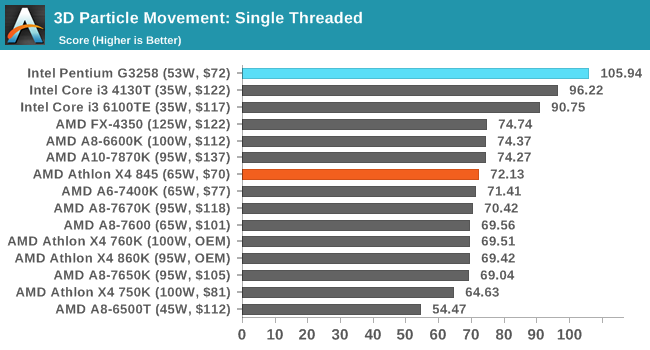
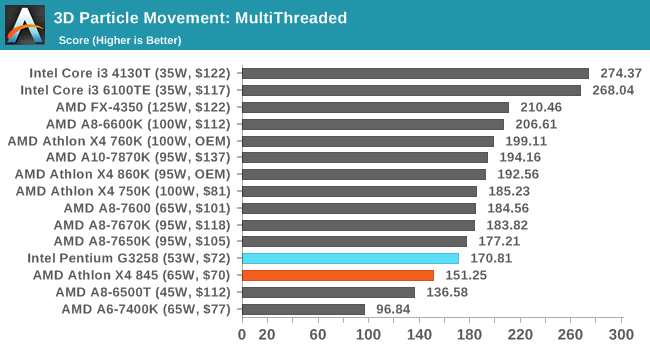
Despite 3DPM v1's coding issues, the multithreaded result is a lot closer than I had originally expected.
Cinebench 11.5 and 10
Cinebench is a widely known benchmarking tool for measuring performance relative to MAXON's animation software Cinema 4D. Cinebench has been optimized over a decade and focuses on purely CPU horsepower, meaning if there is a discrepancy in pure throughput characteristics, Cinebench is likely to show that discrepancy. Arguably other software doesn't make use of all the tools available, so the real world relevance might purely be academic, but given our large database of data for Cinebench it seems difficult to ignore a small five minute test. We run the modern version 15 in this test, as well as the older 11.5 and 10 due to our back data.
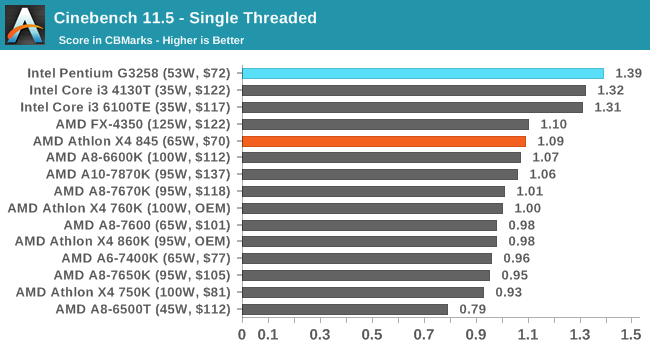
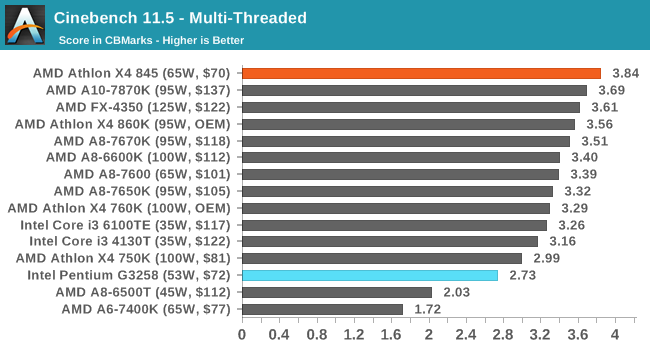
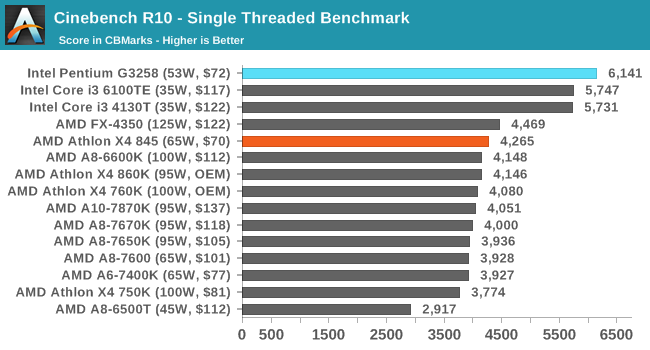

In both CineBench instances we see the high IPC of the Pentium take a 33-50% lead, whereas moving to multi-threaded puts the X4 845 firmly in the driving seat.
POV-Ray 3.7
POV-Ray is a common ray-tracing tool used to generate realistic looking scenes. We've used POV-Ray in its various guises over the years as a good benchmark for performance, as well as a tool on the march to ray-tracing limited immersive environments. We use the built-in multithreaded benchmark.
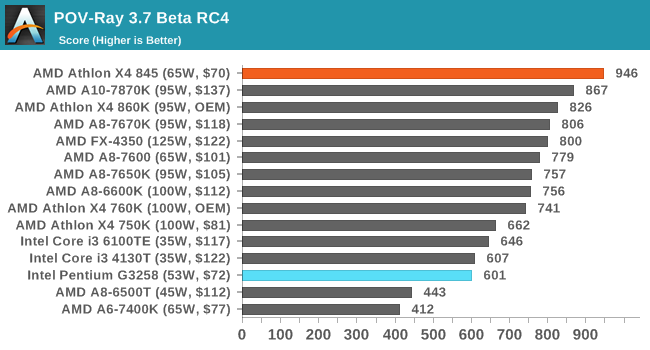
POV-Ray fully exploints all the threads in the system, and the latest AMD microarchitecture helps here as well, pushing the X4 845 beyond the other AMD CPUs in this test and comfortably over the Pentium and low-power Core i3 parts.
TrueCrypt 7.1
Before its discontinuation, TrueCrypt was a popular tool for WindowsXP to offer software encryption to a file system. The almost latest version, 7.1, is still widely used however the developers have stopped supporting it since the introduction of encrypted disk support in Windows 8/7/Vista from 5/2014, and as such any new security issues are unfixed.
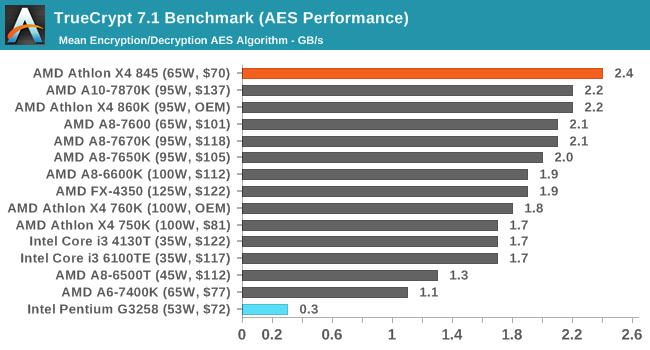
The Pentium lacks AES acceleration, which is available on Core i3 parts and up, which explains the Pentium's low performance here. The Carrizo microarchitecture pushes the 65W part ahead of all the other 95W/100W/125W parts.
x264 HD 3.0
Similarly, the x264 HD 3.0 package we use here is also kept for historic regressional data. The latest version is 5.0.1, and encodes a 1080p video clip into a high quality x264 file. Version 3.0 only performs the same test on a 720p file, and in most circumstances the software performance hits its limit on high end processors, but still works well for mainstream and low-end. Also, this version only takes a few minutes, whereas the latest can take over 90 minutes to run.
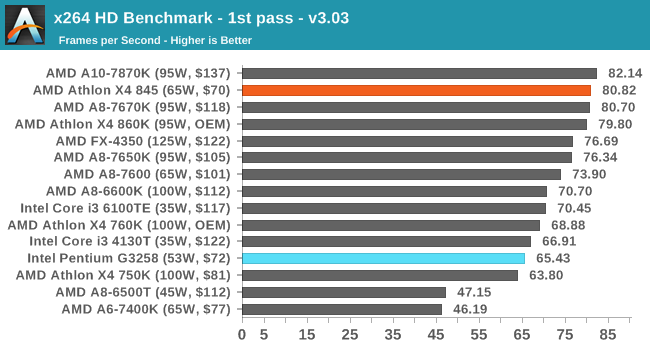
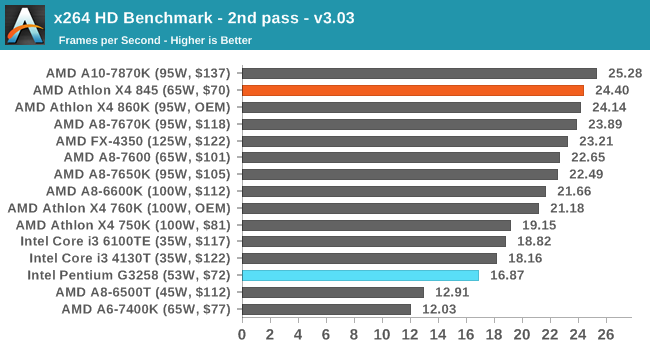
7-zip
7-Zip is a freeware compression/decompression tool that is widely deployed across the world. We run the included benchmark tool using a 50MB library and take the average of a set of fixed-time results.
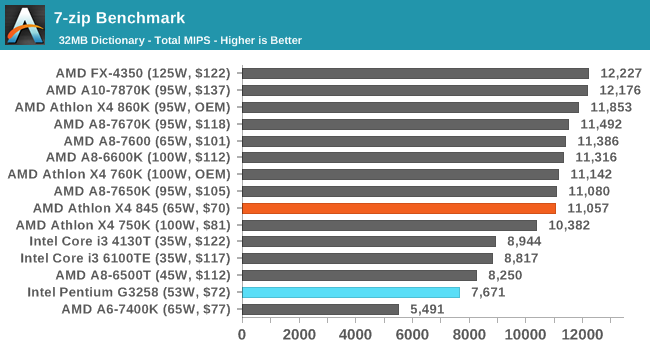










131 Comments
View All Comments
artk2219 - Thursday, July 14, 2016 - link
They had too many parts that weren't hitting their mobile TDP's, or they just bakes too many chips than was needed on the mobile side. Either way, why let them sit in a warehouse or toss them at a loss, when for a very smalla mount you can just throw them into your standard desktop package and make some extra sales.TheinsanegamerN - Thursday, July 14, 2016 - link
Carrizo and kaveri did not use hypertransport. They would have to re-engineer their chip to work on AM3+, and to be frank, the AM3+ market is just too small to justify the tiny margins they would get.That money is better spent on getting zen out of the door.
neblogai - Thursday, July 14, 2016 - link
Why invest into upgrading bad product, when you can sell the same Bulldozer cores till Zen comes? And this Carriso Athlon is just a by-product of a mobile part and can only be sold for desktop. It all makes sense financially. By the way, new Bristol Ridge AMD 15W APUs are really nice and competitive, but laptop manufacturers are failing again- for example, HP Envy x360 comes with FX-9800P APU- again in single channel memory memory configuration, also with HDD installed and without possibility to use SSD. https://hardforum.com/threads/unboxing-1st-impress...TheinsanegamerN - Friday, July 15, 2016 - link
AMD doesnt take the mobile market seriously. If they did, they would be partnering up with the likes of MSI or clevo to produce a good laptop line for their APUs, or at the very least make dual channel a strict requirement.The_Countess - Tuesday, July 19, 2016 - link
AMD unfortunately can't demand much of anything from OEM's currently.and as intel still has a defacto monopoly no OEM wants to piss of intel by making a better AMD laptop.
nathanddrews - Thursday, July 14, 2016 - link
So... will there ever be a desktop Carrizo w/IGP? Much of the hype around Carrizo was focused on its very low power video playback, including H.265 hardware encode/decode.stardude82 - Thursday, July 14, 2016 - link
Isn't that what Bristol Ridge is? But on the new AM3 socket.Arnulf - Thursday, July 14, 2016 - link
AM4.Pissedoffyouth - Thursday, July 14, 2016 - link
Why not bang 8 of these cores into a 125w TDP and make it for FM2+ or AM3+? Finally an upgrade for Piledriver on AM3KAlmquist - Friday, July 15, 2016 - link
If you compare the Athlon 845 with the FX-4350 (link below), the Athlon wins on some benchmarks and loses on others. The Athlon has better IPC, but the FX has a faster clock and a 3rd level cache, leaving no clear-cut winner. If we added an L3 cache to the Athlon chip, that would speed it up, but not by a lot. In other words, Excavator is a big improvement over Piledriver in terms of performance per watt, but not much in terms of absolute performance. An Excavator based FX chip (by which I mean a chip with 8 Excavator cores and 8 MB of L3 cache) would probably be a very marginal improvement over the existing FX lineup at stock frequency, and would have less overclocking potential. I can see why AMD decided not to spend the resources to develop such a chip.http://www.anandtech.com/bench/product/1684?vs=127...